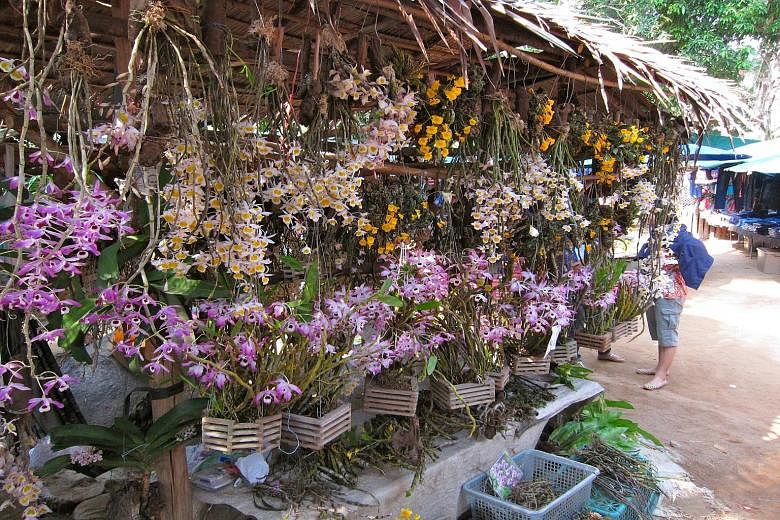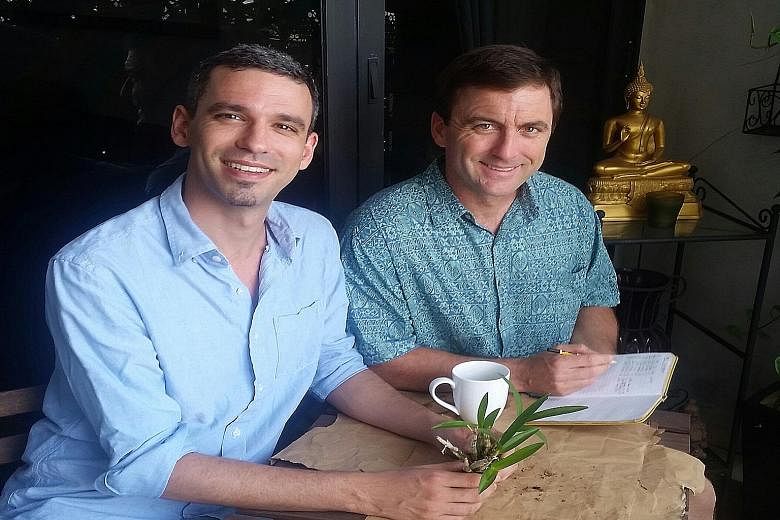Researchers here have uncovered, for the first time, a flourishing black market for wild collected ornamental plants in South-east Asia.
Following extensive surveys of four of Thailand's largest markets, the scientists from the National University of Singapore (NUS) discovered over 300 species of wild orchids traded illegally in the region. Tens of thousands of blooms changed hands within one year.
Some orchid enthusiasts are growing increasingly interested in such blooms, which make their way to countries all over the world, including Singapore, and can sell for thousands of dollars apiece.
But the collection of wild orchids puts at risk wild orchid populations - many of which are rare and little understood.
The study highlights the need for stricter enforcement of rules in the trade, which has remained largely invisible, said the two men behind the study - NUS PhD graduate Jacob Phelps and Associate Professor Edward Webb, from the university's Department of Biological Sciences.
-
Tips for buyers
-
The international trade of all wild orchids is restricted by Cites (the Convention on International Trade in Endangered Species of Wild Fauna and Flora).
Wild plants are unlikely to turn up at wet markets or florists here, although hobbyists looking to buy more unusual plant species might be able to find some, say experts.
-
HOW TO KEEP AN EYE OUT FOR WILD ORCHIDS
• Wild-collected orchids will often exhibit physical signs of leaf damage; irregular root systems with dead roots and tree bark still attached; cracked leaf midribs (the thick, linear structure at the leaf's centre) due to dehydration.
• Ask where the plants come from and ensure you buy plants only from reputable vendors.
• If plants are imported from overseas, make sure they have Cites permits. If sellers claim they are legally-collected from the wild, be suspicious because this is unlikely.
• Avoid buying species plants via online platforms from greenhouses in Thailand, as these are often laundering operations for wild plants.
SOURCE CREDIT: DR JACOB PHELPS
The study, recently published in the Biological Conservation journal, also found other wild-collected ornamental plants sold at the markets, but focused on orchids.
Interviews with traders at Jatuchak market in Bangkok and three markets bordering Myanmar and Laos revealed that most sellers sourced the majority of their plants from neighbouring countries.
This is despite domestic protection and restrictions on the international orchid trade by the Convention on International Trade in Endangered Species of Wild Fauna and Flora (Cites), a treaty to protect endangered plants and animals.
What is even more worrying is that the scale of the black market trade has been grossly underestimated by official government data, highlighting the need to better monitor and enforce rules against this "invisible wildlife trade", said the researchers.
Official government data showed "virtually zero" trade in these countries, said Dr Phelps, the lead researcher of the project. He is now with the Lancaster Environment Centre in Britain, researching environmental crime, wildlife trade and conservation policy.
"In this case, we've simply turned a blind eye to plant trade and botanical conservation. This research also highlights a common problem in the illegal wildlife trade - the invisibility of trades that have not been researched and are not formally recognised, so are not subject to action."
In February 2010 alone, Dr Phelps found 168 wild orchids being sold by one trader, on a single day, at a market bordering Thailand and Laos. But going by official records, only 20 such plants were traded between the two countries over nine years.
He said that while the study was done in Thailand, it applied to Laos and Myanmar, where most of the wild plants came from. There are also anecdotal reports of large orchid trades elsewhere, in places like Indonesia, Vietnam and the Philippines.
While the trade in greenhouse-cultivated orchids and hybrids - common across the world including Singapore - is legal, the global trade of all wild orchids is restricted and requires special Cites trade permits.
But Dr Phelps believes that no wild orchids in the region are being legally traded with permits.
Of the orchids found to be on sale at the markets, the researchers estimated that at least 60 species were at known risk because of trade, with most species so under-researched that they could not even assess the conservation impact of trade.
Several species found in the markets were new to science.
On sale was also the critically endangered Excluded Lady Slipper Orchid (Paphiopedilum exul), which is known to exist only within a 4 sq km area of limestone forest in Peninsular Thailand (see story below).
The black market for wild orchids is estimated to be worth millions of dollars today, and collectors go after them for many reasons, ranging from their large blooms to fragrance and rarity.
Orchids are arguably the largest family of flowering plants, with more than 25,000 species. In Singapore, many of the common greenhouse-grown orchids for sale are usually in the genera Dendrobium, Vanda and Phalaenopsis.
"Some hobbyist collectors are also interested in orchids because there are many species that are very narrowly distributed - found only in certain countries or even found only on specific mountains or valleys - and so are quite rare, which attract some collectors, much like some people chase after rare stamps," said Dr Phelps.
Buyers at the markets hailed from all walks of life. They ranged from those interested in attractive plants for their homes and gardens, to orchid enthusiasts from all over the world seeking rare species. Some people were from Thailand itself, but there were buyers from other countries who then exported the plants illegally, said Dr Phelps.
Associate Professor Henrik Pedersen, an orchid specialist from the Natural History Museum of Denmark, told The Straits Times that orchids have become extremely popular worldwide, and this has generated a demand for as many different species as possible.
"The vast majority of orchid enthusiasts do their best to obtain new items for their collection in a legal way, but it is not always easy to know whether the trade history of a given plant has been consistently legal," said Prof Pedersen.
"I am convinced that a significant portion of the orchids covered by the dubious trade are ultimately sold to end users who are actually ignorant of the illegal status of the plants."
While the exact origins of the orchids at the Thai markets are not certain, they are believed to have been mostly harvested from forests. Their generally small geographic ranges and highly specialised ecology also make orchid species particularly vulnerable to habitat degradation and to collection, noted Prof Pederson.
"Because orchids are both very vulnerable and very popular with the public, they can be characterised as 'the panda bears of the plant kingdom,'" he added.
The study highlights the need for stricter enforcement and a better understanding of trade networks, which also involve those in Singapore. For instance, while conducting the surveys in Thailand, Dr Phelps said they came across traders on buying trips for Singapore and Malaysia greenhouses.
Ms Peggy Tan, president of the Orchid Society of South East Asia, said illegal trade can be stopped only with firm action on the part of governments to control illegal exports and encourage habitat conservation. "We need to conserve species in their natural state, as a great many are still awaiting discovery and identification," she said.
Already, some beautiful wild plants have become extinct because of over-collection and habitat loss. The most notable ones are in the lady slipper group belonging to the genus Paphiopedilum.
They include, for instance, the once abundant Paphiopedilum druryi in India, which botanists are no longer able to locate in the wild.
Prof Webb said that for many people, plants simply fail to generate concern and affection in the way that many animals do.
"While we increasingly hear about the illegal trade of elephant ivory, rhino horn and tiger parts, few people will have heard about the illegal trade in hundreds of plant species for horticulture and medicine," he said.
"Yet, commercial illegal trade is an immediate threat to the conservation of hundreds, if not thousands, of plant species in our region."



